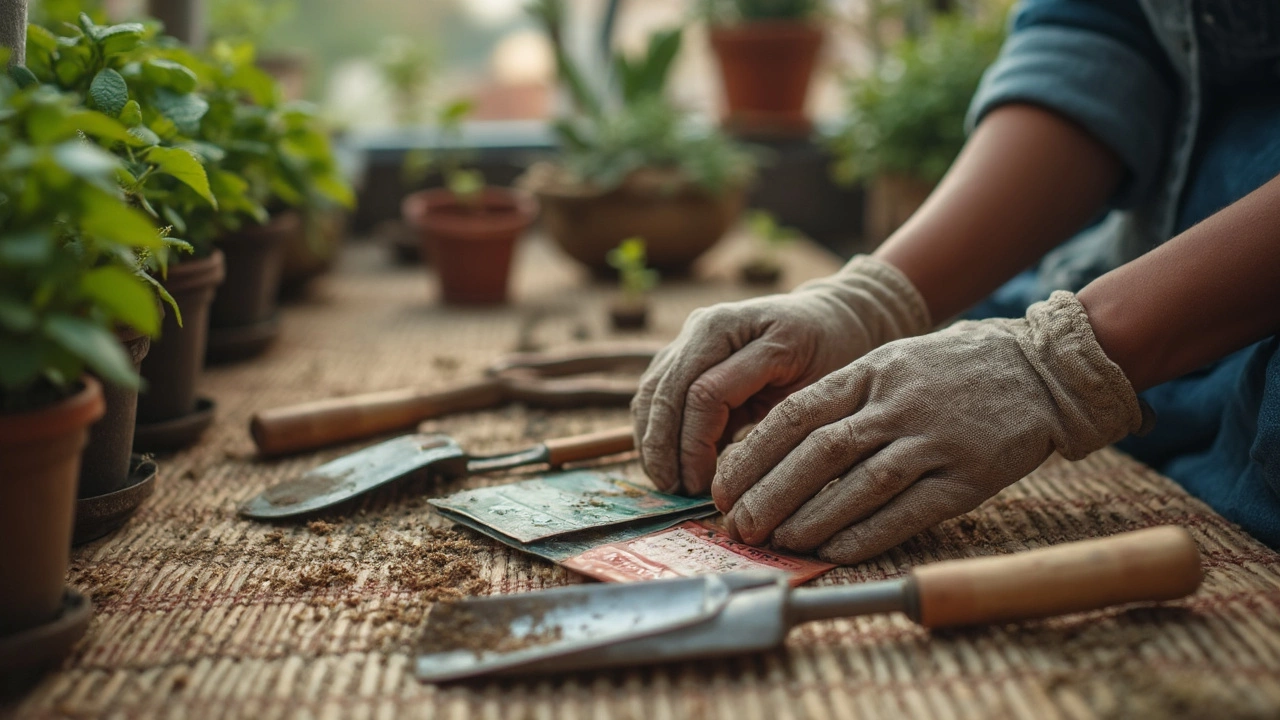You know what really slows down garden work? Crummy tools. I’ve learned the hard way that you can’t just wing it with a kitchen knife or your kid’s beach shovel—things break, and your hands will hate you. The right garden tools don’t just get the job done, they save your energy and your sanity. You don’t need a garage full of gadgets, but a few solid basics make all the difference.
Start with a solid hand trowel, a sturdy digging fork, a pair of bypass pruners, and a good weeder. These tackle most jobs: planting, pruning, and yanking dandelions before they stage a takeover. Forget that old cartoon of gardening as some dainty hobby—digging, chopping, and hauling are real workouts, so anything that makes the work easier actually lets you stick with it longer.
Another tip? Pay attention to the handle. If it feels awkward or your wrist gets sore, swap it out for something more comfortable. My favorite pruners have thick, grippy handles—no more blister drama. Tool quality matters more than quantity, and you can spot the difference after one afternoon in the dirt.
- The Must-Have Basics
- Upgrading Your Toolkit
- Tools for Time-Saving and Comfort
- Extra Handy Add-Ons
- How to Choose and Care for Your Tools
The Must-Have Basics
If you’re not sure where to start, don’t worry—I’ll steer you straight. Every gardener, new or experienced, needs a few core tools. Skip the fancy extras (for now). These are the heavy lifters in any shed and make gardening way less of a headache.
- Hand trowel: This is your go-to for digging small holes, moving soil, planting seedlings, and even pulling up stubborn weeds. Stainless steel ones won’t rust, and a comfy handle will keep your wrist from hating you.
- Bypass pruners: Forget scissors—these are made for plants. They give you clean cuts on live stems and don’t crush soft branches like cheaper options. A sharp blade is safer, so keep them honed.
- Digging fork: You’ll use this for turning the soil, mixing in compost, and loosening up hard patches. It handles roots and rocky spots way better than a shovel alone. Four sturdy steel tines are a must—don’t cheap out.
- Weeder: If you’ve ever fought a dandelion, you already know the pain. A simple forked weeder pops them right out, root and all, without destroying your lawn or raised bed.
- Garden gloves: Not technically a tool, but trust me, your hands will thank you. Look for gloves that breathe and have a bit of grip—you’ll avoid thorns and blisters, plus it keeps your nails halfway decent.
When you use good best garden tools for your basics, gardening actually feels easier—and you’ll notice jobs like planting, transplanting, and cutting back happen faster. You won’t replace these every year, either; grab decent ones and you’re set for seasons to come.
Upgrading Your Toolkit
Once you’ve got the basics, you might notice some jobs taking forever. That’s when adding a few specialized tools can save your back and your patience. For digging larger holes, a long-handled shovel makes short work of tree planting and breaking up tough soil. If you’re dealing with a lot of leaves or mulch, a lightweight garden rake is way better than trying to rake with a broom (trust me, I’ve tried...out of laziness, not genius).
Got raised beds or tight spaces? Try a hori-hori knife. It’s a Japanese hand tool that slices through roots, weeds, and even bags of compost. My friend swears by hers for everything—she’s even used it to split perennials in spring. Another smart upgrade: a wheelbarrow or garden cart. Hauling soil, mulch, compost, or even patio bricks becomes way less of a chore. If storage is tight, look at foldable carts—some of them even collapse flat against your shed wall.
- Long-handled shovel: easier digging, less bending
- Garden rake: faster leaf or debris cleanup
- Hori-hori knife: all-purpose hand tool for planting and weeding
- Wheelbarrow/garden cart: hauling heavy stuff with half the effort
If you want to make the most of your best garden tools, don’t just go for the fanciest item. Weight, balance, and handle fit matter more. Plus, some companies stand behind their products with lifetime warranties—worth a look if you plan to garden more than one season.
For a quick comparison of common upgrades:
| Tool | Main Use | Avg. Price (USD) | Bonus Feature |
|---|---|---|---|
| Long-handled shovel | Digging holes/turning soil | $25-40 | Reduces back strain |
| Garden rake | Gathering leaves/debris | $15-30 | Wider coverage |
| Hori-hori knife | Weeding/planting | $20-40 | Stainless steel blades |
| Wheelbarrow | Hauling materials | $50-120 | Foldable options available |
It’s all about picking the right tool for the job so you spend less time fighting weeds and more time actually enjoying your garden. And when you’re not wiped out from lugging compost, your Saturday afternoons feel a whole lot better.

Tools for Time-Saving and Comfort
If you ask any gardener what they value most besides a healthy back, it’s probably time. There’s always more work than hours in the day, so certain best garden tools can shave off minutes—or even hours—of elbow grease.
First on my list: a long-handled hoe. You’d be surprised how much faster weeding gets with a sharp, lightweight hoe. No more crouching, crawling, or fumbling around under thick veggie leaves. Look for a stirrup/oscillating hoe specifically; it cuts in both directions and clears rows in a blink.
Next, grab a garden cart or sturdy wheelbarrow if you’re tackling big areas. I used to drag buckets around and, not going to lie, my back reminded me every time. With a cart, you haul compost, mulch, soil, and tool piles in one go. If your paths are narrow, a folding wagon can slip through corners no problem.
Watering is another bottleneck. A lightweight but tough hose (kink-free, if you can find it) plus a spray nozzle with adjustable patterns keeps you from wasting time and water. Some gardeners swear by soaker hoses laid throughout the garden, connected to a timer—if you hate daily watering, this is a game changer.
For hand comfort, padded gloves are a must. They protect you from blisters and prickly plants, but also help with grip on slick shovel handles. Go for washable, breathable ones; fabric that stays soggy or stinky isn’t worth it.
If you get tired fast from kneeling, try a foam kneeler or a lightweight garden stool. My knees will thank these inventions even when I’m not fussing over onions.
- Long-handled stirrup hoe (for fast weeding upright)
- Garden cart or foldable wagon
- Quality, lightweight hose with a good spray nozzle or soaker hose
- Padded, breathable gloves
- Kneeling pad or mobile stool for low work
Most people don’t realize how a couple of thoughtful upgrades make gardening actually fun, not just another chore. Even if you only pick one or two of these, you’ll notice a real difference in your garden routine and your mood at the end of the day.
Extra Handy Add-Ons
Once you’ve nailed the basics, it’s worth thinking about a few extra tools that make garden life way smoother. Some of these aren’t absolutely necessary for everyone, but honestly, you’ll probably wonder how you lived without them after the first try.
A kneeling pad is a lifesaver, especially if you tend to get sore knees from planting or weeding. Most pads are made of thick foam and come with a handle for easy hauling around the yard. Garden gloves fall in the same must-try category. Skip the cheapest ones, because they usually rip right away. Aim for gloves with reinforced fingertips if you do a lot of digging or pruning—your hands will thank you.
Next up: a watering wand. These are way better than old-school watering cans, especially when you’re dealing with hanging baskets or tightly packed beds. The long handle lets you reach awkward areas, and many come with a nozzle that lets you control the water flow. According to a test by Consumer Reports, garden wands can save up to 30% water compared to a regular hose nozzle—handy for your water bill and the planet.
Don’t forget about a sturdy wheelbarrow or garden cart. Carrying bags of compost or loads of mulch by hand is a recipe for back pain. If you have a big yard, a double-wheel model is more stable on uneven ground. Here’s a quick comparison of top add-ons and what they’re best for:
| Tool | Best For | Quick Tip |
|---|---|---|
| Kneeling pad | Planting, weeding, anything close to the ground | Look for washable covers |
| Garden gloves | Protection from blisters, thorns, chemicals | Buy two pairs—one always goes missing |
| Watering wand | Easy, targeted watering for beds and baskets | Choose adjustable spray settings |
| Wheelbarrow/cart | Hauling heavy stuff, saving your back | Get a rust-proof, lightweight model |
| Knee-high boots | Muddy jobs, wet areas | Makes cleaning up way faster |
Finally, try a lightweight folding garden stool if you’re working in one spot for a while. A simple stool can save your back and help you power through more planting or pruning. These add-ons may not be in every garden starter kit, but they seriously boost your comfort and make the whole experience easier. If you're aiming for the best garden tools setup, these are worth adding to your stash.

How to Choose and Care for Your Tools
Picking the right gear isn’t about grabbing whatever is cheapest on the shelf. There’s a real difference between a tool that lasts one season and one you’ll still be tossing in your wheelbarrow ten years from now. When shopping, check that the tool feels solid—no rattles, no flimsy joints, no brittle plastic. Give it a test grip. If it feels awkward, skip it. Your hands and wrists need to stay comfortable, especially during the spring rush.
Look for handles made of ash or hickory. Both woods are tough and handle wet weather without rotting. Stainless steel blades are clutch—they cut better and don’t rust as fast. Bonus: stainless tools are easier to hose off after a muddy afternoon. For the most best garden tools, the ideal length and weight fits your strength and height—nobody needs a shovel that’s heavier than a bag of mulch.
Let’s talk care—because even the priciest tool falls apart if you treat it rough. It’s not rocket science, but a few habits save you money and stress:
- Clean off soil and sap after each use. Dried-on gunk can cause rust or make wood handles split.
- Wipe down metal parts with a rag or a little oil. I use a splash of vegetable oil in a pinch—it stops rust and sticks less dirt next time.
- Sharpen blades every couple of months. A quick swipe with a sharpening stone makes pruners and hoes work like new.
- Store tools somewhere dry, not leaning against the fence out back. Hanging tools up in the shed or garage keeps handles straight and blades sharp.
Ever break a tool right in the middle of a big dig? It’s usually because a weak spot gets worse over time—usually from moisture or a crack in the handle. Regular checkups help. Just give everything a quick look when you pack up. If something’s loose or starting to split, fix or replace it before you’re knee-deep in a project.
| Common Tool Material | Pros | Cons |
|---|---|---|
| Stainless Steel | Rust-resistant, easy cleaning, keeps a sharp edge | Often pricier than carbon steel |
| Ash or Hickory Wood Handles | Shock-absorbing, durable, comfortable grip | Can split if left wet; needs oiling |
| Plastic Handles | Lightweight, cheap, doesn’t rot | Gets brittle, cracks, usually not repairable |
One more thing—label your stuff. Sounds basic, but I lost my favorite hand fork for three months because it blended into the mulch. Bright tape or a splash of spray paint on the handle will make your tool easy to spot and saves you from yelling at Max for hiding it.





